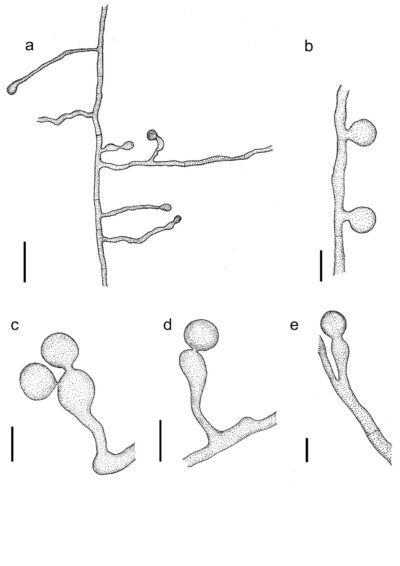Fungalpedia – Note 243, Emmonsiellopsis
Emmonsiellopsis Y. Marín, Stchigel, Guarro & Cano.
Citation when using this entry: Thakshila et al. 2024 (in prep) – Fungalpedia, Onygenales, Eurotiales, and Verrucariales.
Index Fungorum, Facesoffungi, MycoBank, GenBank, Fig. 1
Classification: Ajellomycetaceae, Onygenales, Eurotiomycetidae, Eurotiomycetes, Fungi
Marin-Felix et al. (2015) introduced Emmonsiellopsis as a new genus in Ajellomycetaceae, based on ITS and D1/D2 sequences and typified with E. terrestris. Emmonsiellopsis terrestris and E. coralliformis were isolated from fluvial sediments in Girona, Spain. Emmonsiellopsis is not recorded as pathogenic to mammals, as other genera in this family (Marin-Felix et al. 2015). Only an asexual state has been reported for this genus. Emmonsiellopsis is characterized by smooth-walled, verrucose, spinulose, and rarely septate conidia, born sessile or pedicels. The hyphae are septate, branched, hyaline, smooth, and thin to thick-walled. Emmonsiellopsis terrestris and E. coralliformis are morphologically similar in producing long and inflated pedicels, and the main difference between the two is the maximum temperature of growth (E. coralliformis: 33 °C and E. terrestris: 42 °C), conidial ornamentation, and presence of contorted dendritic mycelium in E. coralliformis (Marin-Felix et al. 2015). According to the ITS and D1/D2 sequences, the Emmonsiellopsis group with other genera in Ajellomycetaceae, such as Blastomyces, Emmonsia, Histoplasma, Paracoccidioides, and Helicocarpus (Marin-Felix et al. 2015). Emmonsiellopsis is morphologically similar to Blastomyces and Emmonsia, having sessile or pedicels, solitary, globose to piriform aleurioconidia, and whitish colonies. However, Emmonsiellopsis differs from Blastomyces, Emmonsia, and other genera mainly due to the absence of thermal dimorphism. Furthermore, Paracoccidioides and Histoplasma differ from Emmonsiellopsis by producing of smooth-walled conidia and tuberculate macroconidia and microconidia with roughened walls, respectively (Marin-Felix et al. 2015). Helicocarpus is distinct from other genera by producing sexual morphs and not produce a yeast-like morph (Rizzo et al. 2014, Marin-Felix et al. 2015).
Type species: Emmonsiellopsis terrestris Y. Marín, Stchigel, Guarro & Cano
Other accepted species:
Emmonsiellopsis coralliformis Y. Marín, Stchigel, Guarro & Cano.
Emmonsiellopsis tuberculata Torres-Garcia, Guarro & Gené
Figure 1 – Emmonsiellopsis terrestris (CBS 273.77, ex-type culture) a Smooth-walled, globose to ovoid conidia borne sessile or on pedicels. b Sessile conidia. c, d Conidia on inflated pedicels. e Sessile conidium and conidium borne on inflated pedicel. Scale bars a = 20 μm, b-e = 5 μm. Redrawn from Marin-Felix et al. (2015).
References
Entry by
Subasingha A. D. Thakshila, Center of Excellence in Fungal Research, School of Science, Mae Fah Luang University, Chiang Rai 57100, Thailand
(Edited by Chitrabhanu S. Bhunjun, Kevin D. Hyde, Samaneh Chaharmiri-Dokhaharani, & Achala R. Rathnayaka)
Published online 22 April 2024
